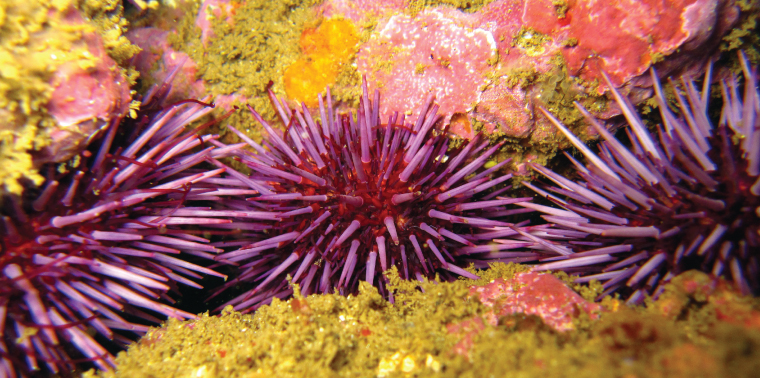To begin to answer this question, scientists are exploring how—down to the subcellular level—marine species are responding biologically to acidification. They are also examining how individual species’ responses may affect marine ecosystems. An adverse impact to one species, or conditions that overwhelmingly favor another, can create imbalances in the marine food web and lead to survival problems for a whole suite of species. And on an even larger scale, scientists are investigating what such changes may mean for fisheries and the people who depend on them, and how marine policy and conservation might respond.
Laboratory experiments are part of the picture. But because ocean conditions are so complex and difficult to replicate, scientists are also conducting research in places like Fogarty Creek. The OMEGAS project, which includes study sites along the northern California and Oregon coast, is tracking ocean pH with offshore sensors while monitoring what’s happening biologically at these sites to intertidal species as seawater becomes more acidic. As UC Santa Barbara professor Gretchen Hofmann explained at the 2012 Ocean in a High CO2 World meeting held in Monterey, Calif., in September, scientists are investigating the “fine tuning of populations to their local environment” in locations now experiencing the most dramatically lowered pH.
Purple Urchin
As Rose and I walk out on the rocks, at first I see only boulders and water. But as I crouch to get a better look, an intricate world comes into focus. Yards of pearly black mussels are punctuated by patches of pale whorled pointy shells of gooseneck barnacles. Beneath the surface of the water, trapped in small pools as the tide recedes, are clusters of anemones that look like upside-down branchless coral. I spot a few fat pink sea stars and several distinct types of algae. Among these are long, bright-green rubbery streamers, short dull olive bristly algae and delicate lacy salmon-colored coralline algae, named for the calcareous skeleton that looks like bones of an exceptionally tiny bird. Deeper underwater, nestled among the anemones, are the creatures we have come to see: Strongylocentrotus purpuratus, the purple sea urchin.
Purple sea urchins are of interest to marine biologists studying ocean acidification for numerous reasons. These creatures live up and down the Pacific Coast where pH is changing markedly. Their habitat is one that naturally varies greatly with the ebb and flow of tides. It is also a highly structured community of species in which the sea urchins play an important role, as a food source for sea otters, in controlling algae and as a component of a healthy ecosystem. They’re also a well-studied species—so well studied that their entire genome has been sequenced, enabling scientists to investigate genetic impacts of ocean acidification. This information is essential to understanding the species’ future and how their fate may affect other ecological community members.
Because the pH recorded on the Oregon coast is much lower than that in California (thanks to ocean circulation, seasonal winds and upwelling), how the northerly purple sea urchins are responding to ocean acidification will help scientists understand what may happen to this whole community of species as ocean pH drops further, explains Kelly. It appears that seawater pH affects how hard the urchins must work to maintain the biochemical balance within their cells. That some seem to be “doing okay” under lower pH doesn’t mean that all is well, says Kelly. It means they’re doing something to compensate.
If urchins fail to thrive, it would likely have an adverse affect on their entire community of mussels, sea stars, anemones, fish and marine mammals.
Tyler Evans, Kelly’s colleague at UC Santa Barbara, is an environmental physiologist and postdoctoral fellow investigating how higher dissolved CO2 and lower pH affect sea urchins’ genes. By looking at the individual genes, he hopes to see exactly which are being altered by the changes in seawater chemistry and how ocean acidification is affecting the genes’ ability to make proteins—among the most basic building blocks of life. Thus far, Evans explains, they’ve identified important changes in how sea urchins’ cells transport calcium and sodium. A balance of these is vital to urchins, both for maintaining healthy cell function and for shell building. If sea urchins have to work harder to maintain this balance, it could affect their development or ability to reproduce. If urchins fail to thrive, it would likely have an adverse affect on their entire community of mussels, sea stars, anemones, fish and marine mammals.
“The behavioral and energy changes needed to maintain yourself as a species are really complicated,” explains National Center for Atmospheric Research scientist Joanie Kleypas, a pioneering ocean acidification researcher. Not only that, notes Stanford’s Palumbi, the costs of coping with changes such ocean acidification may take more than one generation to become apparent.
Similar effects have been observed for species other than the purple sea urchin. In lab experiments, green sea urchin larvae exposed to low pH have grown more slowly and developed physiological abnormalities. Mussels exposed experimentally to low pH appeared to have increased metabolic rates, reduced reproduction and some immune system suppression—all clear indications that acidified conditions are adversely affecting these animals’ physiological functions.
Natural Laboratories
To investigate the ecological impacts of acidification over the long term, scientists are also studying what are effectively natural laboratories for high CO2—places where the gas bubbles up through vents in the ocean floor. One such site is in the Mediterranean, where UC Davis Bodega Marine Lab postdoctoral researcher Kristy Kroeker and colleagues are studying how these conditions affect the ecology of the local reef community.
Reef communities are typically very biologically diverse, with numerous species that each play important roles in the community’s physical structure and food web, explains Kroeker. But under high CO2 conditions, certain algae begin to dominate while the coralline algae that depend on calcium carbonate fare less well, changing what the community provides in the way of food and shelter. Kroeker and her colleagues are investigating how seemingly small changes in these food and structure roles will play out on an ecosystem scale and how this compares to acidification-related changes at sites like Fogarty Creek.
Ensia shares solutions-focused stories free of charge through our online magazine and partner media. That means audiences around the world have ready access to stories that can — and do — help them shape a better future. If you value our work, please show your support today.
Yes, I'll support Ensia!
